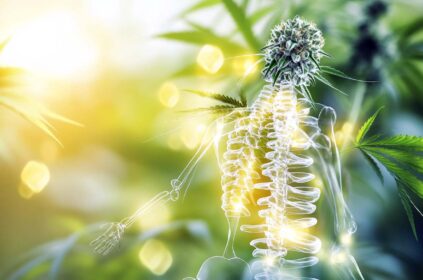Introduction to Cannabinoid Receptors and the Endocannabinoid System
In the astonishing realm of human biology, the endocannabinoid system (ECS) stands out like a hidden thread, weaving through various physiological processes and influencing our health in remarkable ways. This complex network comprises cannabinoid receptors, primarily CB1 and CB2, which interact with both naturally occurring endocannabinoids produced by our bodies and phytocannabinoids found in cannabis plants. Understanding how these receptors function is crucial for anyone interested in the therapeutic potential of cannabinoids, especially CBD.
Distribution of Cannabinoid Receptors
CB1 Receptors
CB1 receptors are the most abundant cannabinoid receptors in the human brain and central nervous system (CNS). They play a pivotal role in many functions, from mood regulation to memory processing. Here are some areas where CB1 receptors are most prevalent:
- Cortex: Responsible for higher cognitive functions such as decision-making and consciousness.
- Hippocampus: Key in forming new memories and learning.
- Amygdala: Involved in emotional regulation and response to stress.
- Basal Ganglia: Critical for motor control and coordination.
- Cerebellum: Influences balance and fine motor skills.
Beyond the CNS, CB1 receptors also appear in peripheral tissues, including the lungs, liver, kidneys, and even adipose tissue. This broad distribution hints at their role in many physiological processes, such as cardiovascular health and metabolic functions.
CB2 Receptors
CB2 receptors are mainly expressed in the peripheral nervous system and are closely tied to the immune system. Their locations include:
- Immune Cells: Found in T and B lymphocytes, monocytes, and macrophages, these receptors play a critical role in managing inflammatory responses.
- Peripheral Nervous Tissue: They help modulate pain sensation without inducing the psychoactive effects associated with CB1 receptor activation.
While CB2 receptors do not generally influence mood or mental state, they are essential for immunity and pain management.
Functions of Cannabinoid Receptors
CB1 Receptors
The involvement of CB1 receptors in various neurological functions is notable. Here’s how they function:
- Neurotransmission: CB1 receptors modulate the release of neurotransmitters, such as dopamine and serotonin, impacting mood, appetite, and memory.
- Pain Modulation: Activating these receptors can inhibit the release of pain-related neurotransmitters, offering a potential pathway for pain relief.
- Cognitive Functions: These receptors are also key players in cognitive processes like learning and coordination.
CB2 Receptors
CB2 receptors focus more on physical health, particularly in managing pain and inflammation:
- Immune Response Regulation: By inhibiting the activation of immune cells, CB2 receptors can decrease the production of pro-inflammatory cytokines, minimizing pain and inflammation.
- Pain Relief: They provide an avenue for pain management without the psychoactive effects often linked to CB1 receptor activation.
Physiology and Health Implications
The Endocannabinoid System
At its core, the ECS comprises naturally occurring compounds like anandamide and 2-arachidonoylglycerol (2-AG). Synthesized on demand, these endocannabinoids can travel backwards across synaptic clefts to inhibit neurotransmitter release, playing an essential role in maintaining homeostasis. The ECS helps us cope with stress, regulate appetite, and relieve pain, among many other functions.
Therapeutic Applications
Understanding the roles of CB1 and CB2 receptors opens the door to numerous therapeutic possibilities:
- Pain Management: Targeting CB2 receptors can be especially promising for chronic pain relief. CBD products focusing on these receptors might provide effective solutions without the high associated with THC.
- Inflammation Control: The anti-inflammatory properties linked to CB2 activation have led to investigations into treatments for conditions such as arthritis and multiple sclerosis.
- Neurological Disorders: Given their influence in the central nervous system, manipulating CB1 receptors could offer therapeutic insights into epilepsy, anxiety disorders, and even conditions like Alzheimer’s.
Market Impact and Trends in the U.S.
As the understanding of the endocannabinoid system deepens, the market for hemp-derived products has witnessed exponential growth. Here are some notable trends shaping this landscape:
- Rising Demand for CBD: Interest in CBD oil and other hemp products has soared, with consumers drawn to their potential benefits for anxiety relief, sleep improvement, and pain management.
- Regulatory Changes: The 2018 Farm Bill legalized hemp cultivation, paving the way for a thriving CBD industry. However, the evolving regulatory environment complicates market dynamics.
- Innovation in Product Development: Companies are continuously exploring new formulations and delivery methods, tailoring products to meet specific health needs.
Conclusion
The exploration of cannabinoid receptors CB1 and CB2 paints a sophisticated picture of the body’s endocannabinoid system, which plays a vital role in regulating numerous physiological processes. As we continue to understand their significance and potential medical applications, it becomes increasingly vital for consumers to remain informed. Whether you’re considering CBD for wellness or just curious about its benefits, knowing how the ECS functions is a step toward making educated decisions.
Actionable Tips
- Consult Healthcare Professionals: Speaking with a healthcare provider can offer valuable insights before starting any cannabinoid-based regimen.
- Prioritize Quality: When choosing CBD products, select those from reputable brands that provide third-party testing for potency and purity.
- Stay Educated: Follow the latest research and news regarding the endocannabinoid system and cannabinoid products to make the best choices for your health and wellness.
By embracing this knowledge and staying informed, you can navigate the expansive opportunities the endocannabinoid system offers and better understand how they can enhance your well-being.
SEO-Optimized Keywords and Phrases
- Cannabinoid receptors
- Endocannabinoid system
- CB1 receptors
- CB2 receptors
- Physiology of cannabinoid receptors
- Therapeutic applications of cannabinoid receptors
- Hemp-derived wellness products
- CBD oil benefits
- Pain relief with CB2 receptors
- Inflammation reduction with CB2 receptors
- Neurological disorders and CB1 receptors
Internal and External Links
For further reading on the endocannabinoid system and its receptors, consider resources from reputable health organizations and scientific literature.
Visuals and Infographics
Incorporating infographics or diagrams that illustrate the ECS’s components, the distribution of receptors, and their roles can further enhance understanding.
This comprehensive overview offers a clear and accessible insight into cannabinoid receptors, their functions, and their impact on health and wellness. By blending informative content with relatable language, it aims to educate readers while inviting them to explore the fascinating world of cannabinoids further.





















